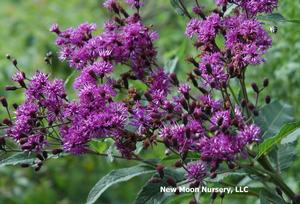Printed at http://www.newmoonnursery.com/index.cfm/
Vernonia lettermannii 'Iron Butterfly'
Iron Butterfly ironweed
Native to North America (selection)
FIRST IMPRESSIONS: Vernonia lettermannii ‘Iron Butterfly’ is a low mounding perennial wildflower with narrow fine textured foliage. In late summer plants are covered by small clusters of royal purple disc florets. Butterflies and other pollinators flock to the florets. This species thrives in dry open woods or in sunny gardens with average well drained soil.
HABITAT & HARDINESS: The parent species Vernonia lettermannii occurs in Arkansas and Oklahoma. Plants are found on rocky flood plains, rock outcrops and gravel bars in the drainage area of the Ouchita River.
The cultivar ‘Iron Butterfly’ originated in Dr. Allan Armitage’s trials at the University of Georgia. This variety was selected for its vigorous growth, compact habit and floriferous nature.
‘Iron Butterfly’ is hardy from USDA Zones 4-9.
PLANT DESCRIPTION: Vernonia lettermannii ‘Iron Butterfly’ is a compact densely branched perennial wildflower.
Blades are linear and about 3” long and 1/8” across. Leaves are entire with pointed tips. They are produced in abundance giving the plant a soft appearance and delightfully fine texture.
From late summer until autumn, plants bear masses of small clusters of deep purple disc florets.
Each floret matures into a brown to gray nutlet with a bristly brown to purple colored pappus.
Plants are 2-3’ tall with an equal spread and are strongly anchored by a sturdy taproot.
CULTURAL & MAINTENANCE NEEDS: Vernonia lettermannii ‘Iron Butterfly’ prefers sunny sites with average to dry soils. Plants tolerate clay, rocky and gravelly soils, alkaline pH, drought and temporary inundation by water.
This species is pest resistant and is not palatable to deer or other herbivores.
LANDSCAPE USES: In bloom or simply in leaf, Vernonia lettermannii ‘Iron Butterfly’ is a dramatic Accent for a Wildlife Garden or Meadow. Plants are lovely in combination with native grasses and golden fall flowers. Plants are also used as Butterfly Nectar Plants, to provide Showy Blooms and Attractive Foliage or as part of a Grouping or Mass Planting. This cultivar can be used in Cottage Gardens, Deer Resistant Gardens, Low Maintenance Plantings, Rain Gardens or Perennial Borders.
COMPANION & UNDERSTUDY PLANTS: Try pairing Vernonia lettermannii ‘Iron Butterfly’ with Baptisia australis, Asclepias tuberosa, Ceanothus americanus, Monarda fistulosa or Rudbeckia hirta.
Amsonia hubrichtii has similar foliage texture and cultural needs and would be a worthy substitute in some situations.
TRIVIA: Unlike most other members of the Aster Family, Vernonia spp. flowers are composed only of disc florets with no rays.
Flowers attract bevies of butterflies, skippers, moths, native bees and the occasional hummingbird.
The specific epithet honors a reclusive field botanist, George W. Letterman (1841-1913) who spent his days searching for rare plants in the Missouri Ozarks. Many distinguished scientists make the trek to his cabin and botanized the woods along the Merrimac with him. In addition to Vernonia lettermannii, species of Poa, Stipa and Crataegus are named for him. Letterman turned down two Harvard professorships and refused to publish preferring instead to spend time in the woods.
The unusual texture of this species has caused many to compare it to another Arkansas native, Amsonia hubrichtii. When not in flower, the species also resembles Liatris spp.
Vernonia lettermannii ‘Iron Butterfly’ is one of Piet Oudolf’s “Must Have” plants and is massed at New York City’s Highline and Chicago’s Lurie Garden.
Height:
2-3 ftSpread:
2-3 ftSpacing:
2-4 ftUSDA Hardiness Zone:
4-9Bloom Color:
PurpleVernonia lettermannii 'Iron Butterfly' Characteristics
Attracts Wildlife
- Butterflies
- Pollinators
Attributes
- Long Blooming
- Drought Tolerant
- Dried Flower
- Cut Flower
- Clay Soil
- Rock Garden
- Rain Garden
- Naturalizing
Exposure
- Full Sun to Partial Shade
Deer Resistant
- Deer Resistant
Flowering Months
- October
- September
- August
Foliage Color
- Green
Growth Rate
- Fast
Juglans nigra Tolerance (Black Walnut)
- Yes
Season of Interest (Foliage)
- Fall
- Summer
- Spring
Soil Moisture Preference
- Moist to Wet

